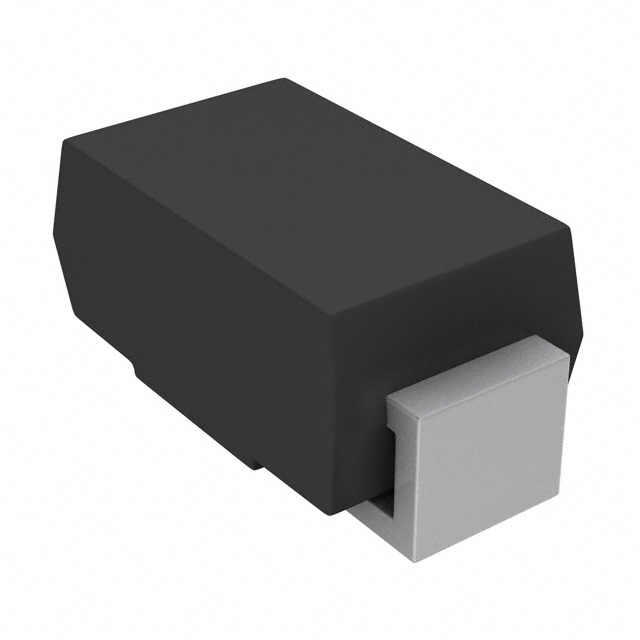Viz Specifikace pro podrobnosti o produktu.

SMAJ33A-M3/5A
Introduction
The SMAJ33A-M3/5A is a diode belonging to the category of transient voltage suppressors (TVS). It is designed to protect sensitive electronics from voltage transients induced by lightning, electrostatic discharge (ESD), and other transient voltage events. This entry provides an overview of the SMAJ33A-M3/5A, including its basic information, specifications, pin configuration, functional features, advantages and disadvantages, working principles, application field plans, and alternative models.
Basic Information Overview
- Category: Transient Voltage Suppressor Diode
- Use: Protection against voltage transients in electronic circuits
- Characteristics: Fast response time, low clamping voltage, high surge current capability
- Package: SMA (DO-214AC)
- Essence: Safeguarding sensitive electronics from transient voltage events
- Packaging/Quantity: Available in tape and reel packaging with varying quantities
Specifications
- Part Number: SMAJ33A-M3/5A
- Peak Pulse Power: 400W
- Breakdown Voltage: 33V
- Operating Voltage: 28.2V
- Maximum Reverse Leakage Current: 1μA
- Operating Temperature Range: -55°C to 150°C
Detailed Pin Configuration
The SMAJ33A-M3/5A has a standard SMA (DO-214AC) package with two pins. The pinout configuration is as follows: - Pin 1: Anode - Pin 2: Cathode
Functional Features
- Transient Voltage Suppression: Provides rapid clamping of transient voltages to protect downstream components.
- Low Clamping Voltage: Ensures minimal voltage overshoot during transient events.
- Fast Response Time: Reacts quickly to transient voltage spikes, minimizing the risk of damage to connected devices.
Advantages and Disadvantages
Advantages
- Effective protection against transient voltage events
- Low clamping voltage for enhanced system reliability
- Compact form factor for easy integration into circuit designs
Disadvantages
- Limited surge current handling capability compared to higher power TVS diodes
- May require additional circuitry for comprehensive overvoltage protection
Working Principles
The SMAJ33A-M3/5A operates based on the principle of avalanche breakdown. When a transient voltage event occurs, the diode rapidly conducts, diverting excess energy away from the protected circuit. This action limits the voltage across the circuit, preventing damage to sensitive components.
Detailed Application Field Plans
The SMAJ33A-M3/5A finds extensive use in various applications, including: - Telecommunications: Protecting communication equipment from lightning-induced surges - Consumer Electronics: Safeguarding sensitive electronic devices from ESD events - Automotive Electronics: Providing transient voltage protection for automotive control systems - Industrial Control Systems: Ensuring reliable operation of industrial automation equipment
Detailed and Complete Alternative Models
- P6KE33CA: Similar TVS diode with a different package (DO-15)
- 1.5KE33A: Higher power TVS diode with a peak pulse power of 1500W
- SMF33A: Miniature surface mount TVS diode with a lower peak pulse power rating
In conclusion, the SMAJ33A-M3/5A transient voltage suppressor diode offers effective protection against transient voltage events in a compact and reliable package. Its fast response time, low clamping voltage, and wide operating temperature range make it suitable for diverse electronic applications.
[Word Count: 529]
Seznam 10 běžných otázek a odpovědí souvisejících s aplikací SMAJ33A-M3/5A v technických řešeních
What is SMAJ33A-M3/5A?
- SMAJ33A-M3/5A is a surface mount transient voltage suppressor diode designed to protect sensitive electronics from voltage spikes and transients.
What is the maximum peak pulse power of SMAJ33A-M3/5A?
- The maximum peak pulse power of SMAJ33A-M3/5A is 400 watts.
What is the breakdown voltage of SMAJ33A-M3/5A?
- The breakdown voltage of SMAJ33A-M3/5A is 33 volts.
What are the typical applications of SMAJ33A-M3/5A?
- SMAJ33A-M3/5A is commonly used in applications such as power supplies, telecommunications equipment, automotive electronics, and industrial controls to protect against voltage surges.
What is the operating temperature range of SMAJ33A-M3/5A?
- The operating temperature range of SMAJ33A-M3/5A is -55°C to +150°C.
What is the reverse stand-off voltage of SMAJ33A-M3/5A?
- The reverse stand-off voltage of SMAJ33A-M3/5A is 33 volts.
What is the response time of SMAJ33A-M3/5A?
- The response time of SMAJ33A-M3/5A is very fast, typically in the nanosecond range.
How does SMAJ33A-M3/5A provide protection?
- SMAJ33A-M3/5A clamps the voltage during transient events, diverting excess current away from sensitive components and preventing damage.
Can SMAJ33A-M3/5A be used in high-frequency applications?
- Yes, SMAJ33A-M3/5A can be used in high-frequency applications due to its fast response time and low capacitance.
Is SMAJ33A-M3/5A RoHS compliant?
- Yes, SMAJ33A-M3/5A is RoHS compliant, making it suitable for use in environmentally conscious designs.

